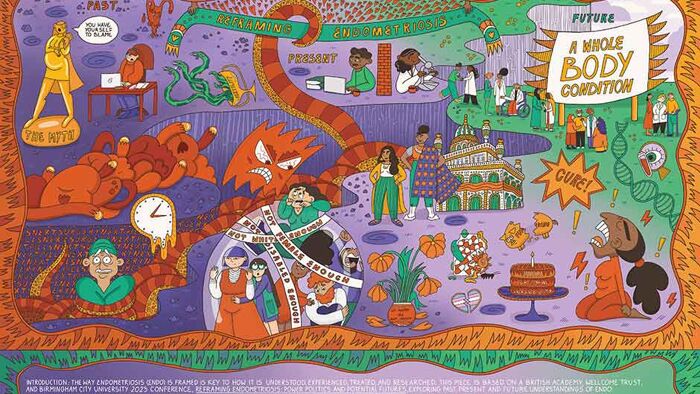REFRAMING ENDOMETRIOSIS
We are delighted to share ‘Reframing Endometriosis,’ a special commissioned illustration from award-winning artist Justyna Green. The piece was funded by the British Academy and Wellcome Trust and based on the ‘Reframing Endometriosis: Power, Politics and Potential Futures,’ hosted at Birmingham City University.
It was the first academic conference to bring together an impressive line-up of endometriosis (endo) social science and humanities researchers alongside prominent (bio)medical researchers, patient advocates and authors. The way endo is framed is key to how it is understood, experienced, treated, and researched. Thus, the conference focused on past, present and future potential framings of endo.
Dr Annalise Weckesser, BCU researcher in Medical Anthropology, was convener of the conference and undertakes research on gendered experiences of reproductive, sexual, and menstrual health inequalities with the aim of shaping practice, policy, and public debate.

Reframing Endometriosis
Past: The myth. You have yourself to blame. Fertility.
Present [research]
Future: A whole body condition.
Cure! Funding [broken]. Pain, Stigma, Infertility. We neither die nor recover. [Barriers] Not female enough, not white enough, not disabled enough.
The way endometriosis (endo) is framed is key to how it is understood, experienced, treated, and researched. This piece is based on a British Academy, Wellcome Trust, and Birmingham City University 2023 conference - Reframing Endometriosis: Power Politics and Potential Futures, Exploring Past, Present and Future Understandings of Endo.
Many endo patients report a health professional has advised 'getting pregnant' to manage or treat their condition. It is a myth rooted in historical medical misogyny and racism.
Endo was referred to as a “career woman's disease” up until the 1990s, based on a myth that it predominantly affected white affluent women who had “put off” having children to pursue education and careers.
The Ancient Greek idea of “hysteria”, where the womb was literally thought to wander throughout the body causing female ailments an irrationality, is alive today in accusations of endo patients as “hysterical” and exaggerating their pain.
Endo patients report receiving medical attention when they want to conceive but not when they want to conceive but not when their daily experience, often riddled with pain, is intolerable.
Medical classifications of endo as a gynaecological, menstrual or “women's” disease focus on the uterus. However, symptoms affect the whole body and, ironically, the condition exists when endo tissue is outside of the uterus.
Due to lack of research funding and education, clinicians do not have good options to offer endo patients. There is no easy way to diagnose it, contributing to a diagnostic delay of eight years on average.
Women of colour, lesbian and queer women, trans-masculine, non-binary and intersex individuals, and young people are underserved and excluded from research, patient activism, and media representations. This has severe consequences to their health.
Endo is called “benign” because it is not fatal (like cancer). This contributes to it not being taken seriously and undermines the severity of the disease for many.
Hormonal (contraceptive) medications suppress and mask symptoms; they are not a cure. They have many side effects and can't be used when people want to get pregnant.
The heartbreak of trans and gender-diverse people not being seen as endo sufferers. Some report that pain was taken more seriously when presenting as male.
Compounding layers of stigma around pain and infertility.
Research funding for “women's health” remains a fraction of that available for “men's health”.
Many communities have to fight for their members to be seen and treated, reflecting the colonial nature of how patients are perceived.
There are many silos that keep people concerned about endo from working together, such as divides between clinicians and researchers, specialists and GPs, social scientists and biomedical scientists, and professionals and patient activists.
Endometriosis has long been considered a disease localised to the pelvis. It is now understood to be a whole body condition. Recognising this can lead to improved research, diagnosis and treatment.
A blood test that could more quickly and less invasively diagnose endometriosis is a hoped-for innovation. Novel research has shown that genetics play a role in determining whether you get endo, and that there is a genetic link between endometriosis and other chronic conditions.
The endo community continues to fight for a cure.
The anger of whole communities for being dismissed for decades.
Improving endo care cannot be shouldered by patients alone. Clinicians, researchers, politicians, and patients must work together collaboratively to bring about change.
Explore this rich, detailed tapestry of an illustration. Justnya herself is an endo sufferer and has won awards for her previous work exploring living with condition. With British Academy support, Justnya attended the conference and has captured key discussions through these vivid images.
To represent the inertia in progress of endo care, the artist used a colour palette that gradually shifts from dark to light. Darker shades are used both in the past (left side of piece) and the present (centre). Lighter shades are only used as we move to the future (right side) with hope for treatment breakthroughs and finding a cure.
Persistent ‘endo myths,’ rooted in medical misogyny and racism, are represented in the piece, including the notion that pregnancy cures endo, the link to ancient notions of a ‘wandering womb,’ and the ongoing exclusion of many marginalised communities from endo care. Images also represent the scandalous underfunding of research for a disease that affects so many, as well as the severe consequences this has on those living with endo.
Pathways to change are represented via images depicting the need to recognise endo as a whole body (rather than a solely gynaecological) condition and the need for truly collaborative research and action that transcends historic and disciplinary silos within the field.
Centre for Social Care, Health and Related Research
C-SCHaRR is a community of health and social care professionals, scholars and students who work together to identify, examine and implement evidence-based high-quality health and social care.
Research is informed and guided through service user’s attitudes, beliefs and experiences and more importantly their involvement in our research through the processes of co-design, co-creation and co-production.
